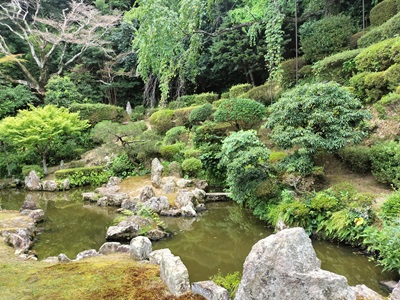“Sesshu”, who was the Master of Suiboku-ga representing Japan 600 years ago, designed and built two gardens in Masuda City at the request of Kanetaka MASUDA, the lord of Masuda Castle. The two gardens are “Ikoji” Temple and “Manpukuji” Temple. Let me introduce you to these two gardens.
1. Ikouji Temple
“Sesshu” built the garden as the seventh chief priest during the Bunmei era (1469 ~ 1486). The Sesshu-teien (Garden) at Ikoji Temple is designated as a national historical landmark and a place of scenic beauty. It is a semi-circuit style garden for appreciating Pond fountain. It is a garden of auspicious omens, with the “Kamejima” as an island that looks like a turtle in the Tsuru-ike pond(Tsuru is a crane). The Kamejima built in Ikeizumi, means Horai Sekigumi (Penglai Rock Formation) as a cliff which is kept away from people in accordance with the Chinese philosophy of Shenxian. This kind of Chinese philosophy of Shenxian was probably expressed when Sesshu became the chief priest of Ikoji Temple after returning from his Chinese training. To the right of the Kamejima is the Tsuru-deshima Island, and on the top is the Toyama-ishi Stone (also known as a mountain stone in “Sumi”), which gives the garden a sense of depth.
Every year in the middle of March the weeping cherry trees blooms, in May there is a blanket of azaleas, in summer the greenery is cool, and in autumn the autumn leaves turn red.
The Ikoji Temple is a temple of the Tofuku-ji branch of the Rinzai sect. It was founded in 1363 and was so prestigious that the General of Muromachi-era appointed a chief priest. Later, Ikoji Temple was opened by Masuda Munekane, who was the 17th lord of Masuda Castle.
It is a nationally designated historic site and place of scenic beauty, a nationally registered cultural property, and a tangible cultural property designated by the prefecture.



Access to Ikoji Temple:
From Masuda station, take a bus bound for Ikoji Temple (15 minutes), get off in front of Ikoji Temple. If you walk from the staion, it is about 40 minutes.
Open:
Summer: 8:30-17:30
Winter: 8:30-17:00
Closed: Winter (January and February)
Admission fee:
Adult 500 yen (400 yen)
High School Students 300 yen (200 yen)
Free for elementary and junior high school
*Discounts fee for groups of 20 or more are shown in parentheses.
Phone: (0856) 22 (1668)
Parking available
2. Manpuku Temple
The stone garden of Manpukuji Temple was built in 1479 by the poet Sesshu, invited by the 15th lord of Masuda, Masuda Kanetaka. The Manpukuji Temple garden is a stone garden that symbolizes the Buddhist concept of the “Mount Shumisen world.”
The stone on the top step in the center is called’ Shumisenseki,’ which is combined with the group of stones seen in Tsukiyama (artificial hills) to create the Shumisenseki-gumi (Shumisen Rock Formation), while the stone directly below Shumisenseki is called ‘Furo-ishi (immortality)’ and the flat stone on the middle step on the right is called ‘Zazen-ishi meditation stone.’
The explanation by the wife of the temple chief priest is very fluent and interesting. It is a very useful story for understanding the garden of Zen, and I hope you will listen to it carefully.
Manpukuji Temple was built in the Heian period as the Masuda training hall of the Jishu sect. It was originally named Anpukuji Temple and was located near the mouth of the Masuda River. However, it was washed away by a large tsunami and was later restored in 1319 by the 4th head priest of Masuda, Donkai Shonin. In 1374, the 11th lord of Masuda Nanao Castle moved it to its current location and renamed it Manpuku-ji Temple, and it was designated as the family temple of the Masuda family.
During the Choshu Conquest and the Battle of Masuda Guchi in 1866, the main gate was destroyed by fire as it was part of the Shogunate army’s camp, but the main hall and kuri (monks’ living quarters) remain intact. The temple is home to cultural assets representing medieval Masuda culture, including the Kamakura-period architectural style main hall (Important Cultural Property), the gardens built by Sesshu (Historic Site and Place of Scenic Beauty), the Niga-Byakudō painting (Important Cultural Property), which represents the teachings of Buddhism, and the Kana-Sansai-Tsubo (Three-color pot), which was brought to Japan by Nanban trade.
It is designated as a national important cultural property and a national site of scenic beauty.



Access to Manpukuji Temple:
From Masuda station, take a bus bound for Ikoji Temple (15 minutes), then get off at Ikoji Temple and walk for 10 minutes. If you walk from the staion, it is about 40 minutes.
Open:
Summer: 8:30-17:30
Winter: 8:30-17:00
Open throughout the year
Admission fee:
Adult 500 yen (400 yen)
High School Students 300 yen (200 yen)
Free for elementary and junior high school
*Discounts fee for groups of 20 or more are shown in parentheses.
Phone: (0856) 22 (0302)
Parking available
3. Sesshu Tomb
There is a Sesshu Tomb in the precincts of Taiki-an Temple where Sesshu is said to have been a chief priest in his later years.



Access to Daikian Temple / Sesshu Tomb
Take the Kyujo-bound bus from Masuda station to “Sesshu Kinenkan Iriguchi” bus stop, and from there it is a 5 minute walk. Take the Tsuchida Line or Obamaezaki Line to the Ion-mae bus stop, and after passing the Ion it is a 15 minute walk to the Daikian Temple.
Sesshu Tomb
Anytime Open


